‘Behemoth’ is a word which springs to mind or, perhaps more nautically, ‘leviathan’.
- Railblaza fittings
- Thermo-welded seams
- Very stable
- Easy to inflate
- Both boats fold away easily
- Explorer is a fun machine
- Navigator configured as a tender
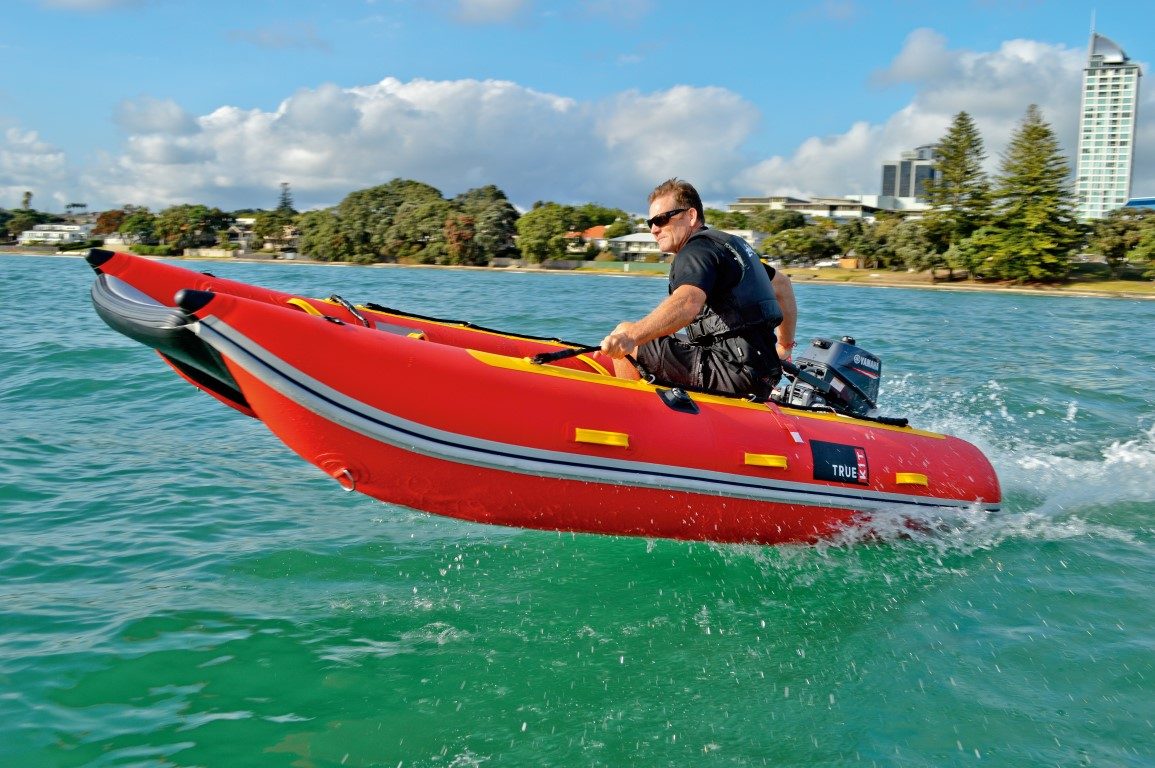
“The tender revolution is upon us.”
Sounds like a statement from a fascist dictator or advertising executives who’ve been at an all-day wet lunch. To truly understand it, you need to be a boatie.
For what seems like a long time the RIB has dominated both the tender and small-fishing-dinghy-fun-machine markets. In the last few years there has indeed been a revolution fuelled by good design and Kiwi ingenuity and True Kit has been in the thick of it all.
The True Kit range is the brainchild of Auckland professional sailor and entrepreneur Rod Dawson. “I grew up on boats and spent a lot of time on the water. I saw a lot of people struggling with small tenders. They were either too heavy or too unstable and we wanted to create a quality dinghy platform that could fold up for transportation and be quick to assemble out of the bag.”
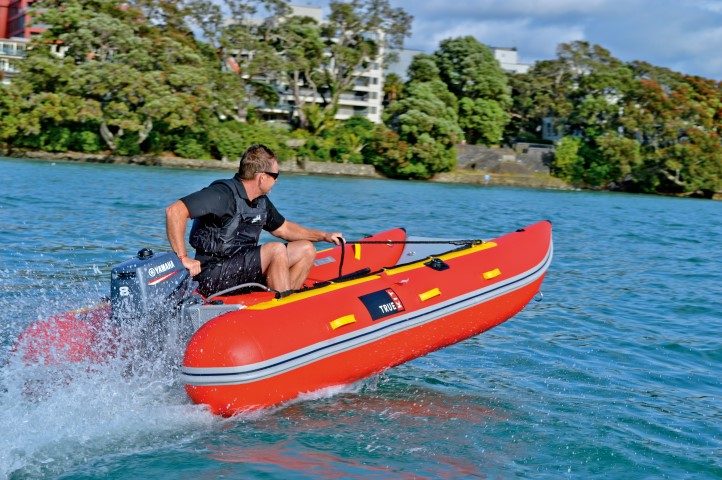
The result of a lot of experience and testing is the True Kit Discovery 3.3m and the True Kit Navigator 2.5m-3.5m. The Discovery has its lineage in the all-out fun of the Thunder Cat, while the Navigator has turned the catamaran platform into a serious knockabout tender.
Assembly
In its folded and bagged configuration the True Kit range is very portable and fits nicely into the boot of even the smallest car. Getting from bag to boat is easy and quick. There are no solid floors or complex components to knot together and you don’t need a YouTube clip to show you how to do it.
The simple trick is to inflate the side pontoons before inflating the floor. You can use a double-action foot pump or, for the less energetic, a handy high-speed electric pump.
In very little time you can have the side chambers up to the required 3psi. The Navigator has three chambers plus the high-pressure floor, making for a good safety margin in case of a puncture. The Explorer has four chambers plus the floor.
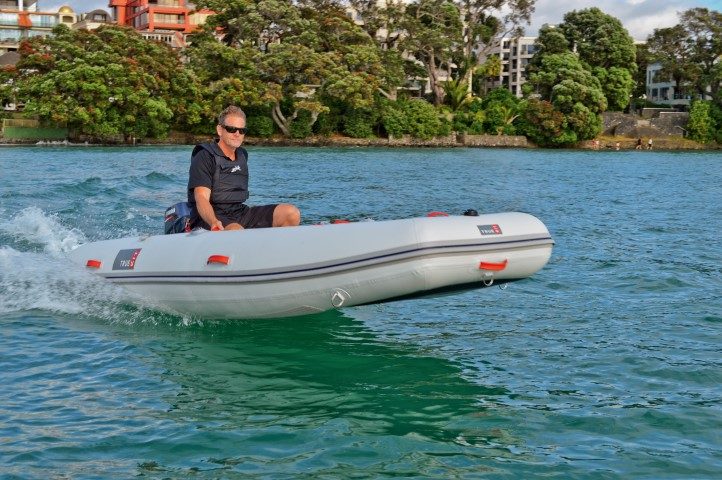
The high-pressure floor is the last piece to go in and looks like a small inflatable stand-up paddleboard. Inflated to 10 psi it not only provides a firm footing, but also stiffens the whole boat so that it has RIB-like solidness.
The outboard is easily attached to the transom and the Beachmaster dolly wheels lowered to make the entire boat easy to move. Two-piece oars fit onto Railblaza mounts on the upper surface of the pontoons. When not in use the oars are stored along the inside of the tubes allowing the tops to be freed up for bums. The mounts can also take rod holders and bait boards for those keen to fish.
Construction
The True Kit range has been constructed with attention to detail and a robustness that bodes well for longevity. The tubes are made in top-quality German 0.9mm 1100 decitex Mehler Valmex fabric.
This fabric is flexible and durable and has great resistance to abrasion which is required for the abuse dished out to tender and fishing boats alike. Tube bottoms and sides are protected with heavy rubbing strips designed to take the punishment from scrapes on rocks, wharves and concrete slipways.
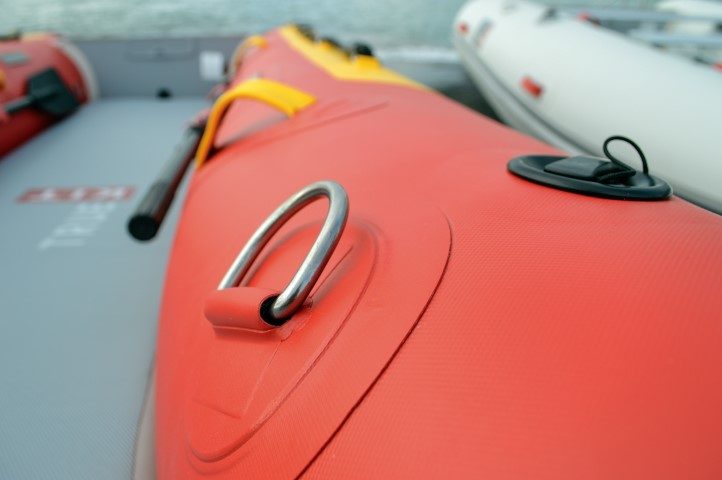
Seams are thermo-welded which gives them up to four times the strength of a glued seam. They are taped to provide extra abrasion resistance and to make for a tidy, strong package. The platform is finished off with a double-bonded transom which provides rigidity to the hulls as well as a strong base for the outboard.
The high-pressure air deck floor is 100mm thick and is held in solid formation by hundreds of internal polyester fibres. The topside of the high-pressure floor is finished off in 5mm of EVA closed-cell deck grip which provides the necessary protection from the usual abuse of sand, fishhooks and knocks that is the tender’s lot in life. The air deck sits above the waterline and is sloped aft so that any water that does find its way aboard flows out the one-way valve in the transom.
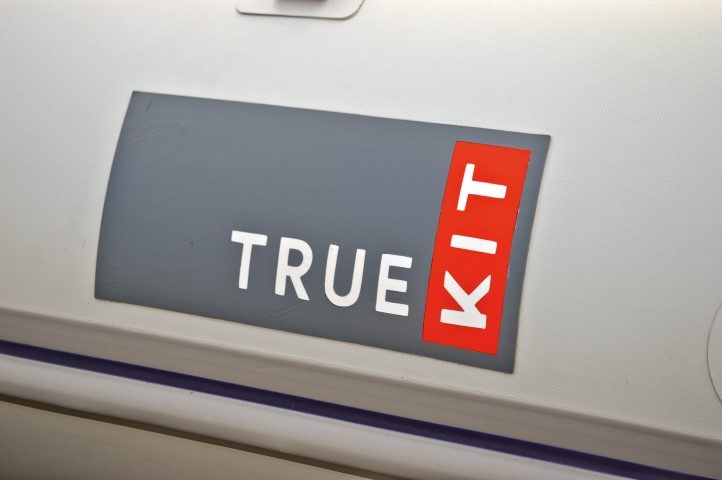
Both the Navigator and the Explorer have sturdy internal handholds, reinforced lifting handles and multiple D rings for lashing gear down.
Launching
At between 25 and 34kg for the Navigator range and 35kg for the Explorer, the True Kits are easy to launch and retrieve. The test boats came with the optional Beachmaster wheels which, in keeping with the rest of the construction, are solid, well thought out and easy to use.
When the wheels are deployed they elevate the stern and make attaching and removing the outboard much easier. Once in the water it is only a matter of flicking them up to store them nicely out of the way of the outboard operation.
Both the 2.5m and 3.0m Navigators look to be within the weight of easy retrieval onto the deck of the mother ship as a one-person job, making them ideal for those who loathe towing a tender.
On the water
With the first light of a summer’s day at Takapuna Beach Rod Dawson appeared with a flotilla of True Kits. The Navigator was there in 2.5m, 3.0m and 3.5m versions, as well as an Explorer 3.3m.
Quality is the initial impression. They are immaculately presented and offer clean lines and sturdy construction. Everything has been thought of, from the Railblaza navigation light fittings to the position and feel of the handholds.
The choice for testing was the Explorer or the Navigator 3.0m, both with 8hp two-stroke Yamahas on the transom. Having eyed the northeast slop surging into Takapuna beach I opted for the Explorer first.
In the True Kit range the Explorer is aimed at the family fun and fishing machine and it is spot on. The deck space is huge for a boat of this size and looks well capable of fitting the family and fishing gear aboard for off the beach adventures. The 8hp was at the bottom end of the recommended horsepower rating, but there was no lack of power with one or two aboard.

Without a large, rigid hull to drag through the water, planing speeds were easy to achieve. Acceleration is instant with the air deck rising clear of the water to give a nice cushioning effect to the ride which was dry and comfortable in the left-over slop.
Cornering was typical catamaran upright style and required holding on tight to the well-positioned handholds. Underway the Explorer is a great hooning boat and at rest she transformed into a stable and comfortable platform for fishing or swimming.
The open bow system rode high enough to prevent any water coming aboard and came into its own as a far easier way to flop aboard after a swim, much better than cracking your ribs while mounting the side pontoon of a RIB.
I could have hooned all morning, but at half time I had to change sides and onto the more tender-oriented Navigator 3.0m. The pedigree and underwater profile is similar to the Explorer, but the Navigator is definitely configured as a tender with seating and storage a more pressing consideration than speed.
The athwartships aluminum seat near the stern made for a comfortable upright helming position, as well as providing a good central weight distribution. With enclosed bow sections, good buoyancy and a generous 700mm inside beam, the Navigator looked capable of holding the never-ending collection of gear and kids a tender is required to tote.
With two straight lines in the water, the Navigator tracked like she was on rails. She had a sure-footedness and stability that boded well for her ability to get from mother ship to beach without a hitch.

Like the Explorer, the platform felt light and stiff. With the ability to work with less horsepower for the same speed and capacity as a RIB, the Navigator is sure to be a hit with the cruising fraternity.
The only problem with revolutions is what to do after they are over. Like an advertising executive at a wet lunch
I wanted to keep hooning all morning. I took this childlike passion as a sure sign that the True Kit range’s high performance, stability, tracking and load carrying capability mean that they are set to lead a new generation of quality inflatable tenders and fun machines.
‘Behemoth’ is a word which springs to mind or, perhaps more nautically, ‘leviathan’.
White Pointer has earned the respect of discerning customers in New Zealand and Australia, attracting a loyal and ever growing following for its high-quality, rugged and totally dependable aluminium trailer boats.
The hardtop SP635 shares the same underpinnings as the popular SF 635 which was a completely new model back in 2020.
The pride and joy of a multi-generational family, Bliss resides on a pier that’s home to a couple of other Elite motor launches – Sandspit Marina is a hot-spot for the Bill Upfold-designed vessels, with several calling this small marina home.